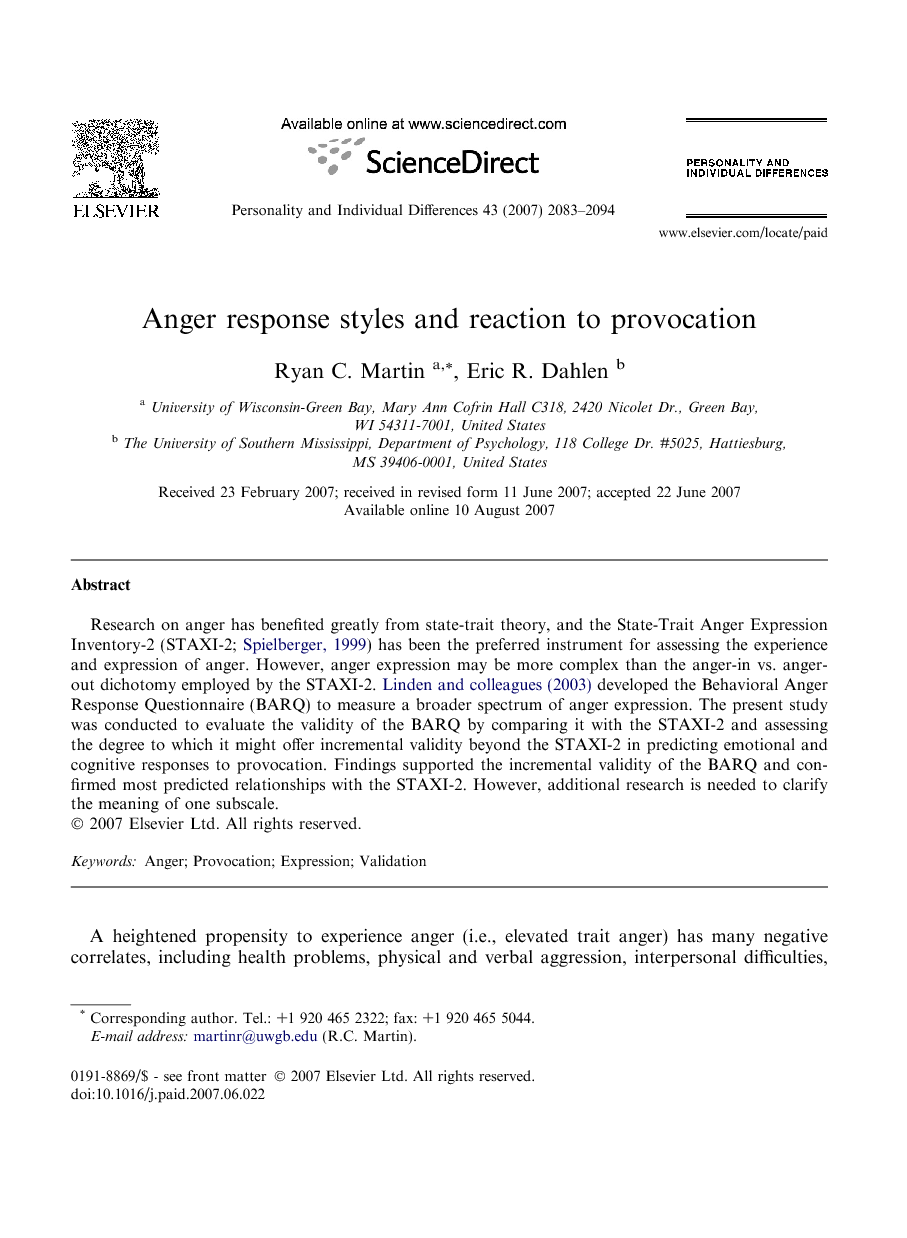سبک پاسخ خشم و واکنش به تحریک
| کد مقاله | سال انتشار | تعداد صفحات مقاله انگلیسی |
|---|---|---|
| 33316 | 2007 | 12 صفحه PDF |

Publisher : Elsevier - Science Direct (الزویر - ساینس دایرکت)
Journal : Personality and Individual Differences, Volume 43, Issue 8, December 2007, Pages 2083–2094
چکیده انگلیسی
Research on anger has benefited greatly from state-trait theory, and the State-Trait Anger Expression Inventory-2 (STAXI-2; Spielberger, 1999) has been the preferred instrument for assessing the experience and expression of anger. However, anger expression may be more complex than the anger-in vs. anger-out dichotomy employed by the STAXI-2. Linden and colleagues (2003) developed the Behavioral Anger Response Questionnaire (BARQ) to measure a broader spectrum of anger expression. The present study was conducted to evaluate the validity of the BARQ by comparing it with the STAXI-2 and assessing the degree to which it might offer incremental validity beyond the STAXI-2 in predicting emotional and cognitive responses to provocation. Findings supported the incremental validity of the BARQ and confirmed most predicted relationships with the STAXI-2. However, additional research is needed to clarify the meaning of one subscale.
مقدمه انگلیسی
A heightened propensity to experience anger (i.e., elevated trait anger) has many negative correlates, including health problems, physical and verbal aggression, interpersonal difficulties, educational and vocational problems, coping deficits, and general negative affect (Deffenbacher, 1992, Deffenbacher, 1993, Deffenbacher et al., 1996a and Hazebroek et al., 2001). Additionally, both aggressive anger expression (anger–out) and anger suppression (anger–in) have been linked to health problems, family violence, and reduced social support (Dahlen and Martin, 2005, Finney et al., 2002, Martin et al., 1999, Siegman, 1993 and Wolf and Foshee, 2003). Research on anger has benefited tremendously from state-trait theory (Cattell and Scheier, 1961 and Deffenbacher et al., 1996b) and instruments based on this theory have been developed to assess anxiety (Spielberger, 1983 and Spielberger et al., 1970) and anger (Spielberger, 1988 and Spielberger et al., 1983). The current version of the State-Trait Anger Expression Inventory-2 (STAXI-2; Spielberger, 1999) includes six subscales to measure the experience and expression/control of anger. The experience of anger is measured by the trait anger (T-Ang) and state anger (S-Ang) scales. T-Ang assesses the tendency to experience anger (i.e., anger proneness) so that higher scores indicate more frequent and intense anger. S-Ang assesses the degree to which one is currently experiencing anger. Four anger expression/control scales assess maladaptive anger suppression (AX-I), aggressive anger expression (AX-O), the reduction of anger through internal controls (AC-I), and the prevention of outward anger expression (AC-O). The STAXI-2 and its predecessor have received considerable support in the literature as psychometrically sound measures of anger and anger expression/control (Deffenbacher, 1993 and Spielberger, 1999). Despite the popularity of the STAXI, anger expression may be more complex than the anger-in vs. anger-out distinction implies, leading some to suggest that the STAXI does not capture the full variety of relevant anger expression styles (Linden et al., 2003 and Riley and Treiber, 1989). Linden and colleagues (2003) developed the Behavioral Anger Response Questionnaire (BARQ) to measure anger expression across a continuum from extreme expression to extreme suppression. The BARQ includes six subscales: (1) Direct Anger-Out (i.e., expressing anger in a verbally or physically aggressive manner); (2) Assertion (i.e., calmly expressing ones’ feelings to the provoker); (3) Social Support-Seeking (i.e., discussing the angering event with a supportive other); (4) Diffusion (i.e., working through anger by listening to music, exercising, etc.); (5) Rumination (i.e., brooding or thinking about the angering event); and (6) Avoidance (i.e., attempting to forget about or avoid the event). According to the authors, Direct Anger-Out, Assertion, Social Support-Seeking, Diffusion, and Avoidance represent the full continuum of anger responses, in order, from expression to suppression. The Rumination subscale adds a second dimension which measures the degree to which respondents ruminate about their anger responses. The BARQ was not intended to measure respondents’ propensity to experience anger (i.e., trait anger) or acute anger levels (i.e., state anger). Thus, it is probably best regarded as a supplement to the STAXI-2 rather than as a replacement. In fact, the primary utility of the BARQ, at least potentially, appears to be its provision of additional information about respondents’ anger expression when administered along with the STAXI-2. The present study was conducted to evaluate the potential utility of the BARQ when used along with the STAXI-2. Specifically, we investigated the degree to which the BARQ might provide incremental validity beyond the STAXI-2 in predicting participants’ response to provocation via a mood induction procedure (MIP) designed to elicit angry feelings. MIPs have been used to induce anger through in vivo provocations ( Siegman, Anderson, Herbst, Boyle, & Wilkinson, 1992), written self-statements ( Engebretson, Sirota, Niaura, Edwards, & Brown, 1999), and written or audio taped vignettes describing anger-provoking events ( Deffenbacher et al., 1996b, Keltner et al., 1993, Martin and Dahlen, 2004 and Rusting and Nolen-Hoeksema, 1998). These approaches have been valuable to the study of anger, allowing for a direct observation of emotions, thoughts, and behaviors while the participant is in an angry state. For the present study, we used an audio taped vignette that was shown in previous research to raise anger levels without substantially affecting other emotions ( Martin & Dahlen, 2004). We predicted that the BARQ would capture additional variance beyond the STAXI-2 in the prediction of state anger and hostile thoughts in response to provocation.

